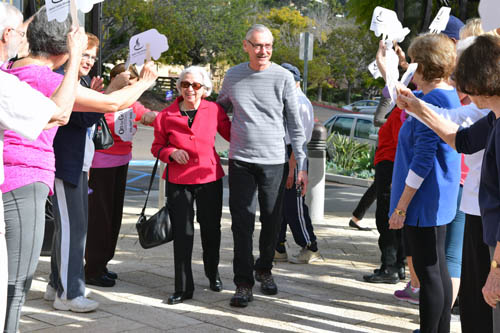
By Donald H. Harrison


SAN DIEGO – If the listing were in an Almanac, it might read something like this:
250,000th ride, Jewish Family Service’s On The Go Senior Transportation, San Diego:
Jan. 20, 2016 Passenger: Anna Ritter. Volunteer Driver: Howard Kugler.
Anna Ritter and Howard Kugler never met before Wednesday, Jan. 20, when he picked her up at her home in the San Carlos neighborhood and took her to Temple Emanu-El in Del Cerro, which is the home of Jewish Family Service’s College Avenue Center.
When they arrived seniors from the center formed a welcoming gauntlet with balloons and placards celebrating the 250,000th ride. Many of them take advantage of the same experience, so the cheers were heartfelt and hardy, even before a television camera from KUSI-TV arrived.
Jewish Family Service coordinates On The Go, which has two kinds of ride opportunities for seniors of all races, religions and creeds. There are buses, which make runs to well-utilized attractions, such as supermarkets and shopping malls, and there are private vehicles, driven by volunteers, which can drive seniors to more specialized appointments.
How did the lives of Ritter and Kruger happen to intersect at this statistically relevant moment when after 7 ½ years of service, On the Go Senior Transportation carried its quarter of a millionth passenger—for an average of 33,333 passengers per year? Now, therein lies a story that takes us through Eastern and Central Europe, New York, and California.
The tale begins with Ritter, 91, who is old enough to be Kugler’s mother. She was living in Zhytomir near Kiev when World War II came to Ukraine. Not yet 18, she had just completed technical courses to qualify her to work in a pharmacy. Keeping ahead of the advancing Nazi German armies, she moved with her family to Tombov, a city in northern Russia, and then later to Fergana, Uzbekistan, where she worked in a pharmacy, then a factory, then joined the Soviet Army, and eventually returned to the factory as an office manager before meeting her first husband, Max Kleinmann, who was a refugee from Poland.
After the war, the couple moved to Krakow, Poland, where her husband had surviving members of his large family, and eventually they found their way to Teshin, a city on the border of Poland and Czechoslovakia. There, they were contacted by a representative of Israel’s Haganah, the pre-state military organization, who asked her to help smuggle into Czechoslovakia a Jewish child who had been hidden during the war with a family in Poland.
She posed as the young boy’s mother—fairly believable because she was obviously pregnant at the time. The boy was dressed as a girl, to discourage any anti-Semite along the way from pulling down his pants to see if he was circumcised.
Once the boy got to Czechoslovakia, the Haganah conducted him to Israel. Ritter returned to Poland with her first husband, but they did not stay for long. They moved next to Munich, Germany, from where, after five years, they were able to immigrate in 1951 to the United States, where Kleinmann opened a New York City painting contractor business.
After raising a son, Joseph, and daughter, Gabrielle, in New York City, Anna was widowed in 1974. . Nathan Ritter, a widower, returned to New York City from San Diego to be present at the unveiling of his first wife’s gravestone. While he was in New York City, he and Anna were introduced. After they were married in 1976, they moved to San Diego, where Anna became stepmother to Hyman and Saul. Eventually she and her husband opened Ritter’s Men’ Wear in National City, which they operated for 18 years. Nathan Ritter died in 2004.
Kugler, 64, was raised in New York City, and after obtaining a bachelor’s degree in economics (and later a master’s degree in marketing), he became a salesman for a toothbrush company, which involved calling on dentists throughout the New York metropolitan area. Eventually he followed a brother to San Diego, and became a pharmaceutical detail man, extolling the virtues of such anti-allergy products as Claritin. He retired after his company was merged with the much larger Merck & Co.
After he retired, he was looking to volunteer and a friend suggested “On the Go,” reasoning that Kugler as a pharmaceutical salesman had driven from doctor’s office to doctor’s office, so driving around town was a lifestyle he was used to. What sold Kugler, however, was knowing what his octogenarian mother-in-law, who doesn’t drive, goes through whenever she has a medical appointment. She is told to be prepared for a bus to fetch her anywhere within a two hour window, and sometimes has to wait in the lobby of the doctor’s office for another two hours after her appointments.
Compared to the buses his mother-in-law uses, a private vehicle providing door-to-door service is a blessing. And, he said, the benefits are not only to the passengers. He said he meets some pretty interesting people, some of whom are quite inspiring. He mentioned one woman whom he thought was in her late 70s, who turned out to be 96 and was still serving as a volunteer at Alvarado Hospital. Another couple, 96 and 93, walks with bags of groceries several times a week from a supermarket to their home several blocks away.
Serving as a volunteer is quite easy, said Kugler. Once someone is accepted into the program, he or she has no required hours. Whenever volunteers want to drive, they sign into the On the Go website, and scan a list of ride requests by neighborhood, date, and time. Each posting has a brief description of how ambulatory the rider is – whether he or she needs a cane, walker, or wheelchair, for example.
Kugler has been a volunteer for approximately 5 ½ years and he has logged between 280 and 300 rides. While some are fairly short – such as Ritter’s ride from San Carlos to neighboring Del Cerro – others from, say, San Carlos to a medical appointment in La Jolla can run some 50 miles roundtrip. The drivers are reimbursed for their mileage.
Ritter, smiling approvingly at Kugler, said that the “volunteers are exceptionally friendly and helpful. They do it with so much love!”
*
Harrison is editor of San Diego Jewish World. He may be contacted via donald.harrison@sdjewishworld.com. Comments intended for publication in the space below must be accompanied by the letter writer’s first and last name and by his/ her city and state of residence (city and country for those outside the U.S.)